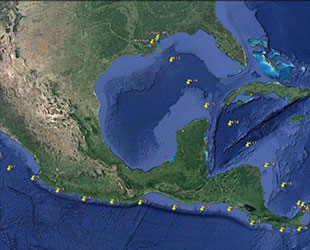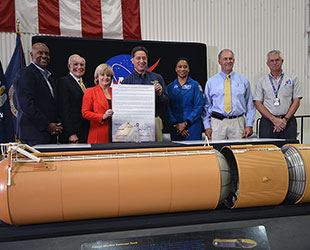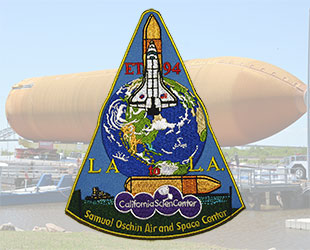April 12, 2016 – NASA's last-existing, built-for-flight space shuttle external tank was launched Tuesday (Apr. 12) on a 40-day sea voyage from New Orleans to Los Angeles, 35 years to the day after the first such tank fueled the maiden flight of the iconic winged spacecraft.
Secured atop an open-air, flatbed barge, the 154-foot-long (47 m) orange-brown tank left the dock at NASA's Michoud Assembly Facility in Louisiana, beginning its journey to the California Science Center for display with the retired space shuttle Endeavour. The exhibit, slated to open in 2019, will be the only place to see a fully authentic space shuttle in a launch pad-like configuration.
"Today is a milestone in history for Michoud and also for the space shuttle program. We bid farewell to NASA's last flight-certified external tank," said Bobby Watkins, director of the Michoud Assembly Facility. "It's hard to say goodbye but we know it is receiving the proper recognition by going to the California Science Center."

Map showing the path ET-94 will take to transit the Panama Canal and be delivered to Marina del Rey. (California Science Center) |
Over the course of the 30-year space shuttle program, the Michoud facility produced a total of 139 external tanks — three test articles and 136 intended for flight. Of the latter, all but one was used to launch the shuttle's 135 missions, the first of which lifted off on April 12, 1981, and the last of which landed on July 21, 2011.
The backbone of the shuttle stack, the external tank was the only major part of the space transportation system that was not recovered and reused. The tank fed the orbiter's three main engines with liquid oxygen and liquid hydrogen for the first eight minutes of flight and then was jettisoned to fall back into the Earth's atmosphere to be destroyed.
Built in 2001, tank no. 94 (ET-94) would have likely helped launch a science-dedicated mission were it not the for the loss of the orbiter Columbia two years later. The sister tank to ET-93 that was used to launch the fallen shuttle, ET-94 was instead used as a test article to validate modifications to return the shuttles to flight.
"Even though it never flew — it was almost there — it was significant to be here when it helped us go through return to flight after Columbia. There were a lot of things linked to ET-94 that were donated to make sure we could make the next flight safe," said Jody Singer, the deputy director of NASA's Marshall Space Flight Center. "So when you think about it, it is really appropriate for ET-94 to be the one that is put on center stage now. It is time for it to have its day and be displayed."

NASA and California Science Center officials present a signed title transfer document for the last external tank, ET-94. (collectSPACE) |
In 2015, NASA agreed to donate the tank to the California Science Center for its display with Endeavour.
On Tuesday, prior to the tank leaving the dock, NASA and Science Center leaders signed a document ceremoniously transferring the title to ET-94 to the Los Angeles museum.
Led by the tugboat "Miss Gloria," ET-94 sailed away from Michoud atop the barge "Gulfmaster I" at 2:15 p.m. CDT (1915 GMT) for the first leg of its trip, a journey along the Intracoastal Waterway to Gulfport, Mississippi. There, the local tug will be changed out for an ocean-going boat, the "Shannon Dann," which will transport the tank-laden barge on a 10-day voyage to the Panama Canal.
The tank's transit from the Atlantic to Pacific Ocean could take as much as a week depending on the ship traffic at the canal. Once through, it is expected the barge will need another 17 to 20 days to reach Marina del Rey, following a brief stop in San Diego, California.

Embroidered patch commemorating ET-94's sea voyage from "LA to L.A." designed by artist Tim Gagnon. (collectSPACE) |
The California Science Center will welcome ET-94 ashore by hosting its annual Discovery Ball at the marina on May 20. As the party wraps up around midnight, the tank, riding atop three wheeled dollies and towed by a custom Mack truck, will embark on a 13- to 18-hour road trip through the streets of Los Angeles to its new home.
At the Science Center, ET-94 will first undergo repairs and have its feedlines and other original hardware re-installed prior to being mated to Endeavour.
"We pledge to not only take good care of it, but use it to inspire the next generation of scientists and engineers for many years," said Jeff Rudolph, president of the California Science Center. "I hope that you will follow ET-94's journey over the next six weeks. We're calling it 'ET Comes Home' because it's coming to its new home."
